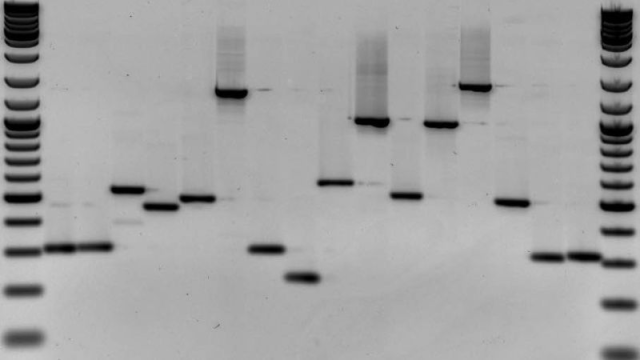In 1986, a technique called “DNA fingerprinting” was used for the first time in a criminal investigation, when a geneticist named Alec Jeffreys realised that when DNA was extracted from cells and attached to photographic film, it developed as a sequence of bars that could uniquely identify someone. His accidental discovery helped nail the suspect in the murder of 15-year-old Dawn Ashworth. Since then, for better and for worse, DNA has become gold-standard evidence that has led to thousands of convictions.
A DNA sequence Image: Wikimedia Commons
Thirty years later, a Dutch investigation into the 1998 murder of 11-year-old Nicky Verstappen has taken forensic DNA testing to an extreme. In order to solve cold case, police have asked 21,500 men in the German-Dutch border area to participate in a massive DNA hunt. The hope is that the mass screening might identify a relative of the killer, whose DNA would be a close match.
Verstappen was found dead in the Brunssummerheide region during a summer camp in 1998. Officials have long suspected the perpetrator came from the area, because of the location in which the body was found. But when leads petered out, the case went dead until a cold-case team began revisiting the investigation five years ago, hoping modern technologies might help solve the crime. New techniques, for example, allowed scientists to identify DNA found on Verstappen’s body and clothes. Testing men between the ages of 18 and 75 years who live near the Brunssummerheide region, they hope, might result in fresh leads if they can identify a relative of the killer.
Dutch police have used such next-of-kin investigations to solve cold cases before. But DNA evidence, while sometimes able to solve tough-to-crack mysteries, can also become problematic when handled improperly, sometimes resulting in false convictions.
Mass DNA testing is an unusual approach to solving a crime, despite recent advances in forensic genetics, in part because of the intensive resources it requires. DNA screenings are also typically more successful when the police can narrow their focus to smaller groups. In the Netherlands, a judge approved the screening. The mass DNA testing began last week, with more than a thousand men showing up in one day to have samples taken. It will likely continue throughout March. Processing that much data, the police said, will likely take the better part of a year.
Mass tests have taken place before, including one of 500 teachers and school boys in a 2014 rape case in France and one of 800 men in another British murder case in 1998. In the 1986 murder case of Dawn Ashworth, police tested 4000 men in Leicestershire before her rapist and killer was caught after he got another man to take his DNA test for him. In Germany, a man admitted to killing a child after 16,400 people were tested and his DNA matched evidence at the scene. The scale of the Netherlands DNA hunt may be the largest yet.
Though testing is typically voluntary, it has still been controversial, especially in the US. Testing can be coercive, some argue, since if you decline to test it appears suspicious.
In the Netherlands, though, police are optimistic – mass DNA testing, they say, may be the only hope to solve the crime.
